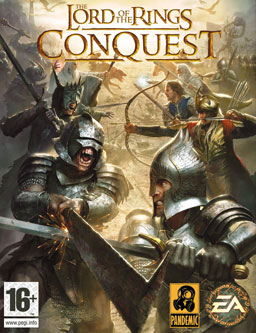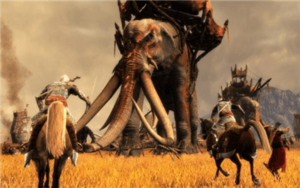The Lord of the Rings: Conquest facts for kids
Quick facts for kids The Lord of the Rings: Conquest |
|
|---|---|
 |
|
| Developer(s) | Pandemic Studios |
| Publisher(s) | Electronic Arts |
| Director(s) | Eric Gewirtz |
| Designer(s) | Sean Soucy |
| Platform(s) | Microsoft Windows PlayStation 3 Xbox 360 Nintendo DS |
| Release date(s) |
|
| Genre(s) | Action |
| Mode(s) | Single-player, multiplayer |
The Lord of the Rings: Conquest is an exciting action game released in 2009. It was made by Pandemic Studios and published by Electronic Arts. This game is based on The Lord of the Rings movies. It also uses many fun ideas from Pandemic's Star Wars: Battlefront games. In Conquest, you can play as both the good guys and the bad guys from Middle-earth!
To make the game, Pandemic Studios got help from Weta Digital. Weta Digital shared their amazing digital models, like the scary fell beasts. The game even includes parts of the story that were cut from the movies. It also takes ideas from J. R. R. Tolkien's original The Lord of the Rings fantasy books. For example, one level is about Gimli trying to take back the dwarven city of Moria from the orcs. The game uses the same music from the Lord of the Rings films, composed by Howard Shore.
Contents
Playing the Game
In The Lord of the Rings: Conquest, you play as a soldier. You might be from Rohan, Gondor, Rivendell, Harad, Mordor, or Isengard. This depends on which story you choose or which side you play on. The game usually asks you to complete tasks. These tasks might be defeating a certain number of enemies or holding a spot for a set time.
If your soldier gets defeated, you start again from that point. Your character's defeat does not stop the story. However, you have a limited number of tries. If you run out of tries, you must restart the whole level.
Game Stories
There are two main stories you can play in the game.
War of the Ring Campaign
This story has eight levels. You follow the big battles from the movies, but with some new parts. These new parts include the Mines of Moria and Minas Morgul. You play as the forces of good in this campaign.
Rise of Sauron Campaign
In this story, you control the evil forces of Sauron. It's a different version of the story with seven levels. This story imagines what would happen if Frodo Baggins failed to destroy the One Ring. In this version, Sauron takes over Middle-earth. Both stories are told by Hugo Weaving, who played Elrond in the movies.
Character Classes
The game uses a class system, like in Star Wars: Battlefront. There are four types of characters you can play as:
Warrior
Warriors are great at close-up fighting with swords. They can block attacks and do special counterattacks. Warriors get stronger attacks by defeating enemies. They can use a flaming sword for powerful spins. They also have a throwing axe for medium-range attacks.
Archer
Archers are best for fighting from far away with their bows and arrows. They have different types of arrows. Fire arrows can knock enemies down and cause explosions. Poison arrows slow enemies and hurt them over time. Archers can also shoot three normal arrows at once. For close fights, they can kick enemies away. A shot to the head can defeat most enemies instantly.
Scout
Scouts are experts at moving quietly and staying hidden. Their main weapons are two daggers. They can become invisible for a short time. This lets them sneak up behind enemies and defeat them quickly. Scouts also carry satchel bombs for ranged attacks. They can block close-up attacks too.
Mage
Mages use magic to fight and help their friends. Their main attack is a lightning bolt. They can charge it up for a stronger attack that hits nearby enemies. Mages also have a "firewall" attack. This creates a circle of fire that hurts enemies inside it. For close range, they have a shockwave that pushes enemies back. Mages can also heal their allies. For defense, a mage can create a magic shield around themselves. This shield protects anyone inside from attacks coming from outside.
Special Units and Heroes
Sometimes, you can play as a powerful Troll or an Ent. These are much stronger than regular characters. However, Warriors and Scouts can defeat them quickly with special moves.
You can also ride animals in the game. The good guys can ride horses. Sauron's forces can ride wargs and Oliphaunts. Riding helps you move fast across big areas. While riding, you use a sword and can trample enemies.
In some parts of the game, you get to control heroes. These are famous characters from The Lord of the Rings. Heroes are much stronger than regular classes. They play similarly to the four main classes but have more power.
Nintendo DS Version
The Nintendo DS version of the game is a bit different. It does not have the Scout class or mounts. The game is viewed from an overhead angle. Characters start weaker but can get stronger by picking up orbs from defeated enemies. After each level, you see your score and can earn achievements.
Game Creation and Release
The Lord of the Rings: Conquest was first announced on May 8, 2008. It was made for Microsoft Windows, PlayStation 3, and Xbox 360. The game was shown at big events like E3 2008. At these events, people could try playing the game.
Pandemic Studios started by making the battlefields from the Lord of the Rings movies. Then, they added more places. The movies were their main inspiration. However, they sometimes changed things to make the game more fun. They wanted to create a "super real" experience. For example, the character of Aragorn in the game does moves that the actor, Viggo Mortensen, might not have been able to do. The original books were also a source of ideas for places and battles.
The developers improved their game engine to allow 150 characters on screen at once. The game uses an updated version of Pandemic Studios' Zero engine. The same team that made the first two Star Wars: Battlefront games worked on Conquest. The game director, Eric Gewirtz, said they were excited to get the Lord of the Rings license.
The music from the film trilogy, made by Howard Shore, is used in the game. The actors from the films appear in cutscenes, which are clips from the movies. The characters in the game look like their movie versions. Hugo Weaving plays Elrond again and tells the story. Other characters are voiced by different actors. For example, Chris Edgerly voices Aragorn, and Yuri Lowenthal voices Frodo Baggins.
The game was first released in Europe on January 9, 2009. It came out in North America ten days later, on January 19, 2009. The first extra content (called DLC) came out on January 29, 2009. It added two maps for a new game mode called Hero Arena. This mode lets up to three friends battle each other. A second DLC pack came out on February 26, 2009. It added three new heroes: Boromir, Arwen, and Gothmog. It also added two new maps and two new Hero Arenas. On March 16, 2010, the online multiplayer parts of Conquest were turned off by Electronic Arts.
See also
 In Spanish: El Señor de los Anillos: la conquista para niños
In Spanish: El Señor de los Anillos: la conquista para niños


